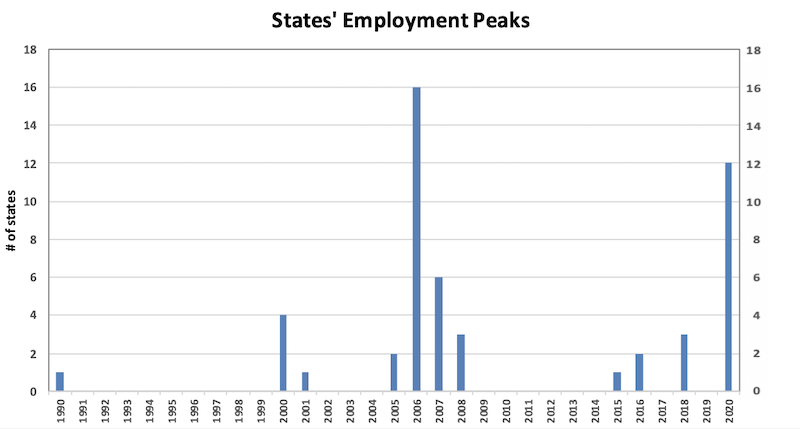Only eight states and the District of Columbia have recouped the severe pandemic-induced losses of construction jobs that occurred last spring, according to an analysis by the Associated General Contractors of America of government employment data released today. Association officials warned that job losses will become even more widespread unless lawmakers promptly renew and expand the loan program that enabled firms to temporarily retain and rehire many workers.
“New spikes in coronavirus cases, along with ongoing pandemic-related costs and revenue losses, are causing ever more private owners, developers, and public agencies to delay and cancel projects,” said Ken Simonson, the association’s chief economist. “Although single-family homebuilding is gathering steam, multifamily and nonresidential construction activity has stalled, leaving large numbers of workers at risk of losing their jobs as current projects finish up with nothing on the horizon.”
Seasonally adjusted construction employment in September was lower than in February—the last month before the pandemic forced many contractors to suspend work—in 42 states, Simonson added. California lost the most construction jobs over that span (-54,900 jobs, -6.1%), followed by Texas (51,800 jobs, -6.5%). Vermont had the largest percentage loss (-24.5%, -3,600 jobs), followed by Iowa (-14.6%, -11,400 jobs).
Of the eight states added construction jobs from February to September, Virginia added the most (4,300 jobs, 2.1%), followed by Utah (3,800 jobs, 3.3%). South Dakota posted the largest percentage gain (9.4%, 2,300 jobs), followed by Utah.
Construction employment decreased from August to September in 17 states, increased in 32 states, and was unchanged in Arkansas and D.C. Illinois shed the most construction jobs from August to September (-3,000 jobs or -1.4%), followed by Oregon (-2,600 jobs, -2.4%) and Iowa (-2,500 jobs, -3.6%). Iowa had the largest percentage decrease, followed by Oregon and New Mexico (-2.0%, -1,000 jobs).
New York added the most construction jobs over the month (5,300 jobs, 1.5%), followed by Louisiana (5,000 jobs, 4.1%) and Washington (4,200 jobs, 2.0%). Vermont had the largest percentage gain for the month (500 jobs, 4.7%), followed by Louisiana and New Hampshire (800 jobs, 3.0%).
Association officials warned that project cancellations are on the rise as new outbreaks of coronavirus across many states force many private owners and public officials to postpone or cancel planned starts. Association officials noted that the rapid adoption of Paycheck Protection Program loans last spring had enabled construction to bounce back quickly from the first round of project shutdowns and delays, and they urged lawmakers in Washington to act swiftly to extend and expand the program.
“The loans that were issued last spring saved tens of thousands of construction workers from unemployment but those funds are rapidly running out,” said Stephen E. Sandherr, the association’s chief executive officer. “Renewal of the loan program should be a top priority for any policy maker who cares about keeping the economy from backsliding.”
View state employment February-September data and rankings; August-September rankings; Highs and Lows.
Related Stories
Industry Research | Nov 30, 2016
Multifamily millennials: Here is what millennial renters want in 2017
It’s all about technology and convenience when it comes to the things millennial renters value most in a multifamily facility.
Market Data | Nov 29, 2016
It’s not just traditional infrastructure that requires investment
A national survey finds strong support for essential community buildings.
Industry Research | Nov 28, 2016
Building America: The Merit Shop Scorecard
ABC releases state rankings on policies affecting construction industry.
Multifamily Housing | Nov 28, 2016
Axiometrics predicts apartment deliveries will peak by mid 2017
New York is projected to lead the nation next year, thanks to construction delays in 2016
Market Data | Nov 22, 2016
Construction activity will slow next year: JLL
Risk, labor, and technology are impacting what gets built.
Market Data | Nov 17, 2016
Architecture Billings Index rebounds after two down months
Decline in new design contracts suggests volatility in design activity to persist.
Market Data | Nov 11, 2016
Brand marketing: Why the B2B world needs to embrace consumers
The relevance of brand recognition has always been debatable in the B2B universe. With notable exceptions like BASF, few manufacturers or industry groups see value in generating top-of-mind awareness for their products and services with consumers.
Industry Research | Nov 8, 2016
Austin, Texas wins ‘Top City’ in the Emerging Trends in Real Estate outlook
Austin was followed on the list by Dallas/Fort Worth, Texas and Portland, Ore.
Market Data | Nov 2, 2016
Nonresidential construction spending down in September, but August data upwardly revised
The government revised the August nonresidential construction spending estimate from $686.6 billion to $696.6 billion.
Market Data | Oct 31, 2016
Nonresidential fixed investment expands again during solid third quarter
The acceleration in real GDP growth was driven by a combination of factors, including an upturn in exports, a smaller decrease in state and local government spending and an upturn in federal government spending, says ABC Chief Economist Anirban Basu.
















